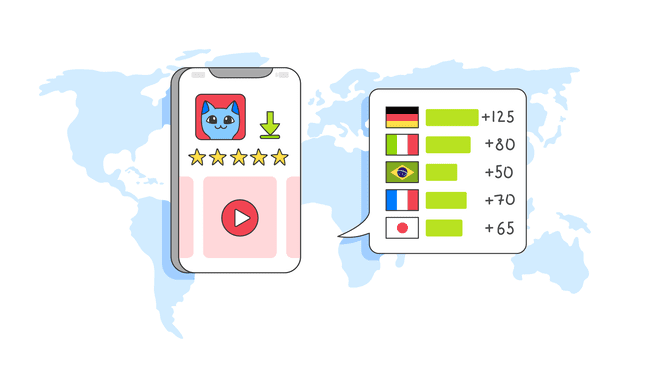Game localization testing ensures that people from different regions and cultures can play and enjoy the game. Localization testing requires testing the game in different languages and ensuring that the content is appropriate for the target audience. Besides, linguistic quality assurance (QA) helps check that all the features and UI elements make sense, text is displayed correctly and does not interfere with the game design, and everything works well.
Game localization testing is an essential part of the localization process, as it guarantees that players from different regions and cultures can play and enjoy a game to the fullest. Though localization is intended to cover this, sometimes minor errors or UI bugs spoil the localization experience. And a flawless UX is crucial for more downloads, in-game payments, and lifetime value. In our experience, a game that has undergone crowd or fan translation usually needs linguistic testing. Large projects with multiple translators that feature complex in-game design and UI elements will also benefit from localization QA.
Why is game localization testing important?
One of the main reasons why game localization testing is essential is that it can improve the user experience. Game developers aim to reach as many players as possible to maximize game downloads, and localization is one of the most effective ways. Game localization testing ensures that the game will work correctly in certain regions so players can experience the same atmosphere and enjoy gameplay as much as players of the original game. By localizing the game, the developer can reach a broader audience and increase the game's potential for success.
Another reason why game localization testing is necessary is that it can improve player satisfaction and, ultimately, loyalty. When a game is localized, it shows that the developer cares about the player experience and has taken the time to make the game accessible and enjoyable for players from different regions and cultures. Players are more likely to be satisfied with a game that has been localized, and they are more likely to recommend it to others.
How is localization testing different from functional testing? Functional testing ensures proper app operation based on technical standards, while localization testing checks how content is perceived by the end user and whether the experience is enjoyable for the players in a given region. Both can be done by the same person, but localization testing requires a careful read-through and understanding of cultural nuances.
Game localization testing is also crucial to avoid cultural misunderstandings and offensive content. Different regions have different cultural norms, beliefs, and expectations. Without proper localization testing, a game may contain content that is inappropriate or offensive to players. This can result in negative publicity, loss of revenue, and damage to the developer's reputation.
Localization testing strategy
Game localization testing involves a series of tests to ensure that the game is culturally appropriate and that its content and features work correctly for different languages, regions, and devices. This testing process involves several steps, including searching for inconsistent terminology, UI issues, grammatical and spelling errors, etc. All this helps to identify and eliminate semantic and technical errors in the product’s textual content before the localized version of the app or game reaches users.
The localization QA approach includes testing games and applications on multiple platforms: iOS, Android, Windows, MacOS, gaming consoles, and browsers. The testing should focus on checking grammar, spelling, punctuation, encoding, string length, style unity. When conducting localization testing it’s also important to identify untranslated strings of words, check for UI errors, verify how units of measurement are displayed, verify that idioms and wordplay are successfully conveyed, and ensure consistency throughout the translation.
Game localization tips from Alconost
To prepare for localization testing, you must keep international development in mind from the beginning by writing code that supports different formats and characters. Outline a clear testing methodology and provide concise documentation. For game testing, prepare a separate build with cheat codes and gameplay videos to help testers. Provide the necessary equipment and support for resolving technical issues. Show testers game trailers or provide a style guide for apps and service projects to ensure appropriate localization.
Alconost has been helping businesses to expand abroad for 20 years. We specialize in all types of localization services, including game localization testing. Over the years we have developed some tips for developing a successful localization testing strategy.
1) Plan game localization in advance
As soon as you start developing a game in your native language, plan ahead to localize the game into multiple languages. Develop a program that supports bidirectional text and non-Latin typographic features. Additionally, the program should support various time and numeric formats, sorting methods, and other related elements. To achieve this, incorporate Unicode, which permits the use of different character code architectures.
2) Outline the methodology and start testing early
After integrating localization into a test build, establish a precise methodology to avoid overlooking any important details. This involves creating documentation and strategizing how to test the game, app, or website. The documentation doesn't have to be excessively lengthy but should provide helpful guidelines. It is also essential to start testing the game localization as early as possible. This will allow you to identify any issues with the localization and fix them before the game is released.
3) Test all languages
When testing a game's localization, it is important to test all the languages into which the game is being localized. This will ensure that the game works well in all the target regions. Testing all the languages will also allow you to identify any issues with the translation or localization that may need to be addressed. For a game project, be sure to provide a game trailer. For an app or service project, offer testers insights into the style, such as the tone and level of formality or informality. This is particularly crucial when English is the source language and for French, Spanish, or German target language projects, where the correct form of 'you' depends on the level of formality required.
4) Refer to native speakers
Using native speakers to test the game localization is crucial. Native speakers will be able to identify any issues with the translation or localization that non-native speakers may miss. They will also be able to provide feedback on the appropriateness of the content for the target audience.
5) Test in different regions
Testing the game in different target regions is essential to verify that it works well in all of them. Different regions may have different technical specifications, internet speeds, and cultural preferences.
6) Test with different devices
It is essential to test the game localization on multiple devices with different technical specifications, screen sizes, and resolutions, to ensure that it works well on all of them. Also, if your project requires special equipment (such as a VR headset), it’s in your best interests to provide it so that the language service provider can select a translator based on their niche experience rather than on whether they have a rather uncommon piece of equipment. For these cases you'll also need to provide technical support for the device on occasions when the test build breaks down or gets buggy and prevents translators from conducting further testing.
7) Test cultural references
Players from different cultures may not understand cultural references in your game. It is important to be sure that cultural references are not offensive or inappropriate for the target audience. This is something we handled well when helping to localize the Samedi Manor game into seven different languages without losing its original functionality or ideas.
Conclusion
As you see, game localization testing is an essential part of the game development process. It ensures that people from different regions and cultures can play and enjoy the game and have the best possible UX.
Alconost offers a full range of game localization and testing services. Our linguists are gamers at heart, and they will play your game extensively to ensure that they have a thorough understanding of it. Our team has worked on 1500+ projects and helped to localize and test game texts and other content. Contact us for your custom localization testing project today.







